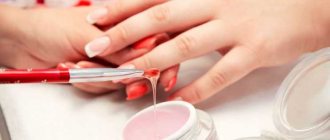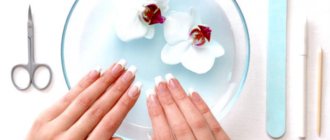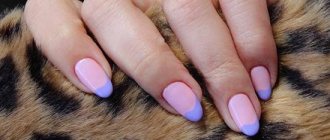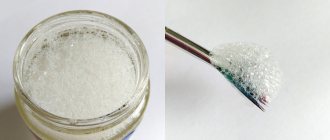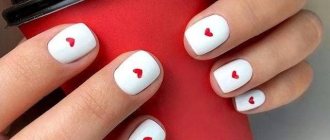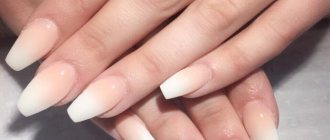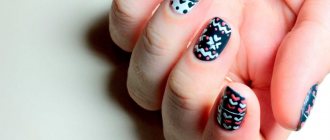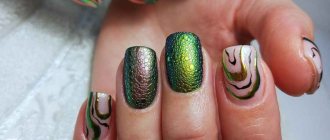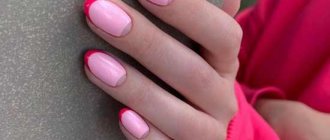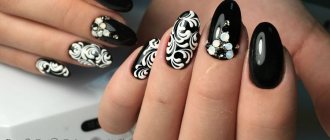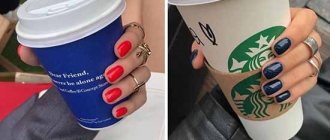Appearing last year, manicure with foam bubbles captivated masters and representatives of the fair sex. Foam manicure (bubbles nails) creates an amazing and unique texture and is harmoniously combined with other types of techniques. Thanks to the combination of effectiveness and ease of execution, the design has become a popular trend for 2022.
Manicure using the bubbles technique is unique due to its wide range of textures, similar to natural ones.
Using this method, you can get various visual effects on your nails:
- mineral;
- reptile skin;
- sea foam;
- lunar surface;
- fish scales;
- soap or air bubbles.
To create each effect, you need your own set of materials and color palette of gel polish. They are united by the use of ordinary soap foam.
What is bubble manicure
Bubble design is a type of manicure in which the surface of one or more nails is covered with bubbles. Despite the apparent complexity of execution, creating such a coating is quite simple. If you wish, you can do this yourself without contacting a manicurist.
The peculiarity of the design with bubbles is the ability to recreate interesting and unusual effects. Depending on the color and texture, the design on the nails can imitate reptile skin, lunar craters, honeycombs, porous chocolate, and thin lace. A foam manicure is created using available materials: soap bubbles, shaving cosmetics, etc.
For short nails
On short nails, you can be a little bolder and cover the entire nail with foam. Due to the small area, there will be no feeling of pretentiousness and oversaturation.
When choosing a color, be guided by the occasion, your own desires and fashion trends. Pastel shades, classic black, and the 2022 color blue are still popular.
Black manicure ideas
Manicure in blue tones: design ideas in different techniques and textures
Blue manicure ideas, combinations and tones
Pros and cons of bubble nails
Advantages of bubble design:
- Versatility. Manicure looks good on any nails, regardless of their length and shape. On a small plate, the bubbles will look like neat stone beads, which will appeal to lovers of jewelry made from natural materials. If you want your nails to look more impressive, you should grow them to the desired length or resort to extensions. If your own plate is weak and thin, it can be strengthened with a base or acrylic powder.
- Practicality. Manicure with foam is characterized by the presence of a rough, ribbed surface. But despite this, the design is comfortable to wear. It does not cling to clothes and does not require special care. Dirt and cosmetics that get into the cells are quickly removed when washing your hands (including when using a soiled matte top). Thanks to this, the manicure retains its beauty as the nail plate grows (until the next visit to the master). To ensure that the design does not cause inconvenience during wearing, it must be carried out in compliance with technology.
- Easy to create. Different tools and means are used to apply decor, so the master can choose what he is more comfortable and accustomed to working with. Thanks to this, foam nail design is completed as quickly as possible. Some specialists apply bubbles with tip sticks, others with a fan (makeup) brush, and still others with their fingers. It is especially convenient to work with your hands if the foam is thick.
This decor option also has disadvantages. These include the following:
- Dependence of wear time on the initial condition of the nails. When creating a manicure, the plate is covered with 4-5 layers of material. This is a significant load that only healthy nails can cope with. If they are initially damaged, additional reinforcement will be required. Otherwise, the condition of the plate will worsen, and the nails may be damaged when performing household and work tasks.
- The need for careful adherence to technology. The last stage of the manicure is “combing” the texture - removing the prickliness with the help of nippers or a buff. If this is not done, the design will be uncomfortable to wear. Nails will cling to hair and clothing and leave scratches on the skin. Another important point is that the foam should be evenly distributed over the surface of the plate (from the cuticle to the free edge). Large margins look unsightly and disrupt the visual integrity of the design.
- The need to work at speed. You need to create a design quickly, because bubbles burst quickly. The master processes 1 nail at a time: evenly distributes the foam and immediately sends the client’s hand into the lamp.
To avoid mistakes, you should understand how to do a manicure correctly. You must act strictly according to the instructions, without skipping a single step.
Fashionable nail designs with bouillons
You can cover your nails with broths in any way you like: cover the entire nail surface with them, place them on the nail hole, complement the design, etc. Favorite designs include caviar, gradient, and patterns. But there are no limits to imagination, right?
Caviar manicure on all nails
Making a real “boom” out of small balls on your nails turns out to be a fashion trend, it’s called caviar design. A scattering of small beads is placed on the entire surface of the nail, and the color can be the same for all nails, or it can combine several. There are even special mixes of broths, when different colors of balls are mixed in one bottle.
Caviar manicure is suitable for both short and medium-length nails. On long nails, bouillons do not look so impressive, and they are uncomfortable to wear. It is more logical to make a “game” on the natural nail plate, so as not to layer the thickness. You should not make such a design if your everyday look should be strict and without frills. Not suitable for women of respectable age.
SONY DSC
Focus on one or two fingers
By complementing any manicure technique, you can make an interesting design on several nails. Any accent is allowed: a simple pattern, a scattering of broths (caviar manicure), an addition to the picture, etc.
The design, which is made in a different color from the main coating, stands out well. For example, for pale blue nail art, “caviar” on several nails in the form of golden broths is suitable.
French or moon manicure
Small balls are inconvenient to wear only on the tip of the nail, so when creating a French or lunar nail art, the broths are placed on “convenient” areas: the base of the nail or the direction from the cuticle to the middle of the nail plate.
It is important to decorate a classic French manicure or lunar nail art with stylish applications made from bouillons and other decorative materials: cut liquid stones, rhinestones and bouillons, etc. It is also trendy to emphasize the smile line with small balls, imitating pearl beads.
French manicure with broths French manicure with broths
Lunar design with bouillons
Creating patterns and drawings with broths
Creating a caviar design, although the technique is simpler, the painstaking work of applying the broths in the form of a beautiful pattern will give a stunning result and will not leave the manicure unattended. The labor-intensive process can also pose difficulties if patterns and designs are laid out on quick-drying compounds (transparent varnish, for example). In this regard, a gel polish top coat that dries only under a UV lamp is more convenient.
With the help of small balls you can lay out monograms, apply geometric designs, make dotted decorations with broths, and decorate nails with a design already applied. There are plenty of options, and finding your favorite is only possible through trial and experience.
Drawings with broths Drawings with broths
Patterns with broths
Stretching with broths or gradient
Even with small balls you can make a beautiful and effective gradient. It is done according to the principle of a caviar manicure, and the transitions between colors occur by smoothly mixing colors for a gradient. Between the broths you can make inclusions of rhinestones to match the manicure, larger balls, semi-beads, etc.
Another gradient option is to partially cover the nail with broth. This is done in the direction from the tip of the nail to the middle, gradually reducing the density of applying small balls to the nail.
Stretching with broths
Gradient broths
Stretching with broths Gradient with broths
3d design
Three-dimensional graphics are now used in various areas of life, even in manicure. Using bouillons, making such a 3D design is quite simple, since the balls themselves are already a three-dimensional figure. Performing a 3D style manicure in technique is no different from the usual use of broths in manicure, but requires careful thought before starting nail art and detailed laying out of small beads.
Among the options for this design are floral nail art, imitation of beads, chains, etc. This manicure is complemented with other decorative elements in the style of a three-dimensional image: semi-beads, rhinestones, modeling, etc.
Wedding manicure with white broths
Even a beautiful wedding manicure can be done using these tiny broths. Simple ornaments and patterns can add a “zest” to a wedding design. It is advisable to use white broths for manicure if the bride’s image contains elements in the form of pearls (pearl beads, bracelet, dress embroidery, etc.) or the outfit is not burdened with any decorative items.
Cat eye manicure
Decorative varnish with a cat's eye effect can also be decorated with broths. The most popular option for this design is to frame the liquid stone on the ring finger with small balls coated with metal (gold, silver, etc.). The stone is placed at the base of the nail or in the middle, and a layer of broth is formed around it.
It is effective to do a manicure with a cat's eye and bouillons on medium-length or short nails. Small balls can be used to decorate any part of the nail, placed on selected nails or on all of them, it all depends on the intended design.
Manicure cat's eye with bouillons Nail design - cat's eye with bouillons Nail design with bouillons in the cat's eye style
How to choose the right materials for foam design
To avoid any difficulties when creating bubble nails, you need to prepare the necessary tools and materials in advance:
- manicure accessories (scissors, nippers, spatula, file, buff);
- base, single-layer gel polish, top (liquid or medium thickness);
- soap scum;
- tool for applying foam (brush, sponge, etc.);
- paper napkins
- other: gloves, antiseptic, cuticle softening oil, hand cream, disposable gloves (if necessary).
You can choose any means for creating foam. The bubble effect is achieved by using household chemicals for washing dishes, shaving and washing foam, and soap. You can try several options and understand which one is more convenient to work with.
To obtain a pattern with small bubbles, the product is mixed with water and shaken vigorously for a long time. Large cells are obtained if you shake the mixture briefly and lightly.
Step-by-step instructions for caviar design using gel polish
Broths essentially stick to the surface, so for a good “adhesion” you need to create a sticky base. For the gel polish base for broths, the usual traditional preparation is carried out. Step by step it looks like this:
- perform a hygienic manicure by removing the cuticle, treating the side ridges, and forming the free edge of the nail;
Hygienic manicure before starting design - after sanding the surface of the nail with a buff, apply primer and base to the nail and dry; Nail preparation
- Apply the first layer of color coating and dry. Then apply a second coat and dry again; Application of color coating
- Apply special glue to the nail and sprinkle it with broth. To adjust the location of small balls, you can use an orange stick to move small elements along the nail, and you can simply press the broths to the surface of the nail with your finger; Design with bouillons
- dry your nails and run a brush over the nail to remove any loose balls;
- “seal” the manicure around the edges with the top so that the broths do not interfere with everyday wear and do not fall off on the first day, dry.
“Sealing” the nail
The glue holds the broth longer and this manicure looks more aesthetically pleasing. If there is simply no glue, then a top without drying is used instead: the desired design is laid out on it and then dried in a lamp.
Nail design with bouillons and gel polish
Manicure with broths and gel polish
How to do a foam manicure: step-by-step instructions
You need to make bubbles on your nails in stages. The instructions for performing a manicure are as follows:
- Treat the nail plates, preparing them for further work. Perform a hardware, edged or combined manicure. Remove gloss with a buff. Apply degreaser and acid-free primer.
- Create the first layer using a base (rubber or tint camouflage). The material is applied in 1 layer and dried according to the manufacturer's requirements.
- After the base has dried, cover your nails with colored gel polish. The material can be either dark or light (depending on personal preference). The only requirement for shellac is high density.
- The next step in creating bubble nails is to dry the coating and remove the sticky layer. Apply a glossy or matte topcoat and dry thoroughly in a lamp.
- Apply a second coat of top, but in a thin layer (using a semi-dry brush). There is no need to dry it in a lamp.
- Apply foam and distribute over the entire nail plate. Put your hand into the lamp.
- Moisten a paper towel with a degreaser and remove any remaining foam.
- Check the coating for any protruding areas that may subsequently cling to clothing and hair. Cut them off with pliers or remove them with a buff.
There is no need to apply a third layer of topcoat.
Nail design with foam is done step by step. Skipping at least one step will result in a decrease in the quality of the coating.
Textured foam manicure with texture
A bubble manicure creates a rough surface on the nail surface. The grooves from the bubbles can cling to hair and become clogged with cream or soap. Most women prefer not only beautiful, but also the most practical designs.
If the design turns out to be too rough, you can carefully smooth the surface with a fine-grained buff. Then apply a layer of finishing coat. The number of layers depends on the desired effect.
You can achieve the opposite effect by using gel paint without a sticky layer. This material has a thicker consistency than gel polish, does not require fixing with a top coat, and is resistant to abrasion. Traces from bubbles (craters) will have a pronounced and defined texture. This material is produced in a wide range of colors.
Types of bubble manicure
Bubble manicure gives room for imagination. Proof of this is the large number of varieties, each of which has its own characteristics.
Main types of manicure:
- Lava (pumice) effect. Nails are covered with gel polish of the same color, the result is fixed with a matte top coat.
- "Cat". It involves a combination of soap foam and coatings that create volumetric glare (magnetic rubbing, etc.).
- Foil under foam. It is performed using single-color shellac, matte or glossy foil.
- Colored foam on a contrasting background. Nails are coated with shellac and dried in a lamp. A layer of gel polish of a contrasting color is applied on top, and foam is distributed over it (without pre-drying).
- Rubbing. Foam manicure looks good in combination with any products (especially those that imitate jewelry or metals).
- Rhinestones. Jewelry can be of any shape. The main thing is that they are combined with the selected texture and shade of shellac.
- Smooth foam. After applying the foam, the nails are carefully polished and covered with a glossy top coat. This allows you to create beautiful highlights, make wear more comfortable and last longer.
- Neon foam. Involves the use of bright, “screaming” pigments. A good option for brave, confident girls. These nails look best in summer (especially in combination with tanned skin).
- French. The nail is covered with pastel pink or soft beige varnish, and a different color and soap bubbles are applied to the crescent-shaped tip. If desired, several nails can be done using this technique, and the rest can be covered with a single-color varnish.
- Three-dimensional decor. 3D elements go well with the foam design option. These can be sliders, volumetric flowers, patterns and shapes. If necessary, liquid metal can be used. To make such a design beautiful, you need to have good taste. If you go too far with the number of decorative elements, the manicure will look funny and even vulgar.
Design ideas
Manicure with bubbles in 2022 has become a separate trend in the nail art industry. As mentioned earlier, there are a number of options in which it can act as an independent, full-fledged design in various versions. So, for example, the pattern may be present on all 10 fingers of the hand or only on some, creating an accent. Foam design can cover the entire surface of the nail, have a chaotic or geometric arrangement.
Today, nail service professionals offer a lot of ideas for combining foam and other existing techniques, namely:
- gradient;
- aquarium;
- French;
- stamping;
- patterns;
- marble.
The gradient can be made by rubbing, pigments or gel polishes of various shades. Aquarium technology creates the effect of sparkling water with bubbles. To do this, when modeling the nail, a foam pattern is created on the first layer of material. A clear construction gel is then applied to the substrate to create the architecture. This technique often uses fimo decor, the shape of which resembles fruit.
The classic French version can be complemented with several nails with a bubble design. A design in which the foam pattern follows the line of a smile looks more original. When combining techniques such as stamping, patterns (monograms, geometry, drawings), marble drawing, a pattern of bubbles is applied to the nail in fragments.
The location depends on the idea and individual preferences:
- horizontally;
- vertical;
- diagonally;
- along the smile line;
- chaotic.
Nail service professionals continue to experiment with variations of foam manicure, so this list is constantly updated with new items. Not every woman has the skills to perform the previously listed techniques.
For such cases, manufacturers of nail art products have developed various decor:
- rhinestones, stones, broths;
- sparkles of various sizes;
- marmalade for nails, velvet sand;
- sliders, stickers;
- foil (potal, tear-off, transfer);
- cobweb;
- dried flower
The use of these products significantly reduces the time required to perform a manicure. A huge advantage of using them is the ability to create an original design with minimal skills.
Over the past 10 years, nail services have advanced significantly. Taking into account the wishes of consumers, manufacturers constantly improved their products and developed new materials. And the masters experimented with new techniques for using them. This is how a large number of popular manicure techniques arose. Designs with bubbles have become popular due to their ease of implementation, the ability to realize fantasies and uniqueness.
Nails with foam over regular polish
Not every woman has the opportunity to constantly use shellac (due to lack of time or money). Some girls are allergic to gel, which forces them to opt for classic varnishes.
It is difficult to answer the question whether a foam manicure will last without fixing it in a lamp. The length of time you can wear a bubble design depends on various factors (products used, care, etc.).
You cannot count on the fact that classic varnish will last as long as gel.
But this method has an important advantage - the ability to update the design more often and try on different images.
Another difficulty when using classic varnish is that without drying in an ultraviolet lamp, the bubble quickly bursts. Therefore, creating a design requires skill.
Foam manicure with rhinestones
The easiest way to diversify the foam design is to use bouillons, rhinestones, and stones. This type of decor is easily accessible, easy to use, and has a wide selection of shapes and colors. The placement of rhinestones or the whole composition depends on the general idea of the manicure and individual preferences. A manicure made with bubbles along the entire plane of the nail can be complemented with single rhinestones of various sizes, arranged in a chaotic manner.
When the sun's rays hit, their refraction will create the effect of constant flickering. A composition consisting of a set of rhinestones, stones and bouillons is appropriate in designs where only part of the nail is occupied by a bubble pattern, or on a nail that is completely free of roughness. Masters often use a similar move, leaving one or two nails of one hand to create an accent.
Table of materials used for fastening the decor:
| Material | Properties | Application |
| Top without stickiness | It has a liquid consistency and adds gloss. Low degree of strength. | Flat and small rhinestones. |
| Base coat | The consistency is medium thick. Provides stronger adhesion of the decor to the surface. | Large rhinestones, compositions, bouillons, medium-sized decorative stones. |
| Construction gel | The density ensures reliable fastening. | Compositions made of rhinestones and stones of various sizes. |
You can replace the thick gel with a mixture of acrylic powder and base coat. Along with gels, such a composition is capable of high-quality fixation of massive structures. The nail has an arched architecture, so it is more difficult to hold the composition with a liquid consistency. Nail service professionals recommend carrying out the decoration procedure in stages. First of all, the material selected for fastening is applied to the intended location of the decor.
After laying out several elements, you can grab the result in the lamp for intermediate drying. It is worth considering that the shine of rhinestones and stones dims when fixing compounds come into contact with their surface. Therefore, it is necessary to work with great care and precision. The broths are completely saturated with the composition (transparent) before application.
Bubles nail design tips
To avoid mistakes when designing bubbles, you need to follow the following recommendations:
- Strengthen thin nails before designing.
- Strictly follow the sequence of actions.
- Use thick shellacs, which are applied in 1 layer.
- Send your hand into the lamp immediately after applying the foam.
- Treat nails one at a time.
- After drying in the lamp, inspect the finished work for any thorny areas. Remove protruding jagged edges with a buff or nippers so that the bubble manicure will last a long time and your nails will not catch on anything.
Manicure with foam No. 2 – texture design
For several seasons in a row, the texture of crocodile or python skin has been on trend. This year will be no exception. So, foam on nails can create a very interesting effect, similar to these materials. In step-by-step photos I'll demonstrate how to make the popular lizard design.
I used a fairly bright green color as a basis. By the way, green will be very popular this summer, in all shades, from lemon green to mysterious dark green.
Next, I painted a lizard with black gel paint. Before creating the design, I covered the nail with the thinnest layer of topcoat without any residual stickiness. Why is this necessary? Some gel polishes and gel paints quickly spread over the surface, and the outline of the design becomes blurry and ugly. To avoid this, you need to remove stickiness from the work surface. Then, while drawing, you won’t have to periodically dry the image in the lamp.
After the lizard was drawn, I covered the tips with a velvet effect topcoat.
It took off the stickiness when the top cooled down a little after the lamp.
Next, I took the topcoat (again, without stickiness) and applied it with a thin brush only in the area of the drawing.
Immediately she carefully placed the foam on top of the drawing and quickly sent the tips into the lamp.
After drying, foam bubbles appeared only in the area of the drawing, like scales. To complete the manicure, simply walk over the entire surface with a clinser.
Now you know how to make individual designs using foam. To prevent the top and bubbles from spreading, you need to act very quickly.
